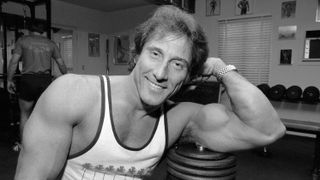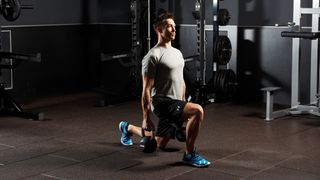
If you don’t step into the gym with a plan, it can be easy to end up wasting your time, drifting from free weights workouts to cardio machines at random. That’s even more likely if you’re a relative beginner.
The three weights workouts below can help ensure every minute you spend in the gym is used wisely. You can combine the workouts into a training plan where you do each of them once a week as detailed below, or pick and choose the workouts as you like.
A bit like this push/pull workout plan, the sessions are based around movements. One workout focuses on pushing exercises that hit the chest, quads, shoulders and triceps. The second workout involves pulling moves that work your back, hamstrings and biceps. Finally, in a departure from a typical push/pull split, the third workout includes rotational exercises that strengthen the core.
The balanced approach of this weights workout will build all-over functional strength, and you’ll see benefits that translate to day-to-day life as well as when playing sport, while also improving your performance in the gym as you get stronger and leaner.
You’ll need a variety of free weights for the workouts, with a barbell, dumbbells and kettlebells all involved, and you’ll need a weights bench for the push session as well, so it’s best to do these workouts in a gym, especially so you can adjust the weight you lift for each exercise. Choose a weight which will make the last few reps of each set challenging. You’ll have to discover how heavy that is with trial and error, but if ever in doubt err on the lighter side, make a note and progressively increase the weight with each session until you find that sweet spot.
How to do these free-weights workouts
Follow the sets, reps and rest instructions for each move to get the maximum benefit. Do each workout once a week for four weeks, aiming to increase the amount you lift each week – and make sure you note how much you lift in each session to track your progress and keep yourself motivated.
How To Warm Up For These Weights Workouts
When you’re working with heavy free weights it’s vital to warm up before you start your session. Not only will you reduce your risk of injury, but you’ll also ensure you’re ready to excel from your first rep onwards, rather than struggling with your first few sets while your body gets accustomed to the idea you’re working out.
A warm-up doesn’t have to take more than five to ten minutes, but it does have to be linked to the workout you’re about to do, so don’t just jump on the treadmill and then assume you’re ready to lift heavy weights.
Start with this dynamic stretching routine to get your muscles moving, and then move on to some workout-specific exercises. With the workouts below, the simplest way to do this is to run through a round of the exercises you’re going to do, using very light weights or no weights at all. That way you’ll know for sure you’re working the exact muscles you’re about to test.
When it comes to preparing for bodyweight exercises like diamond press-ups, you can do a shortened set during your warm-up round or opt for an easier variation like press-ups with your knees grounded. Remember you’re just aiming to get the muscles firing, not exhaust yourself before the workout proper begins.
Workout 1: Push
1 Dumbbell bench press

Sets 3 Reps 10 Rest 60sec
Why The week kicks off with a double header of everyone’s favourite move – the bench press. You start with the dumbbell version because you’ll go a bit lighter than with a barbell, and it’s better for warming up your shoulders because you have to work harder to stabilise the joint.
How Lie on a bench with your feet on the floor directly underneath your knees, holding the dumbbells above your chest. Lower them to your chest, then drive your feet hard into the floor and push the dumbbells back strongly to the start position.
2 Incline bench press
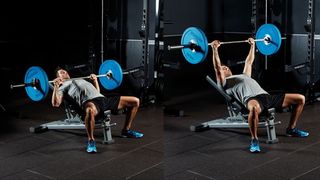
Sets 4 Reps 6 Rest 60-90sec
Why The incline version of the move puts a slightly different emphasis on your muscles, working the front shoulders a bit more than the flat version does. You’ll probably find you can’t lift quite as much weight because of this.
How Lie on a bench set at a 45˚ incline, holding a bar over your chest with your hands just wider than shoulder-width apart. Lower the bar until it’s touching your chest, then press it back up.
3 Back squat
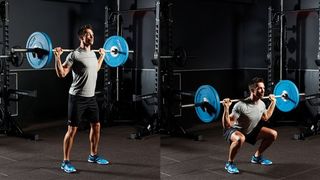
Sets 5 Time 5 Rest 90sec
Why The king of the legs moves works your entire lower body and, when you go really heavy, turns into a whole-body move as your entire upper body is recruited to control your torso and prevent your body from slumping. It’s a really useful, functional exercise so, if your mobility permits it, you’d be wise to make it a cornerstone of your training programme.
How Rest the bar on your back with your feet roughly shoulder-width apart, toes pointing out slightly. Keep your spine in alignment by looking at a spot on the floor about two metres in front of you, then sit back and down as if you were aiming for a chair. Lower until your hip crease is below your knee. As you drive back up, keep your weight on your heels.
4 Overhead press
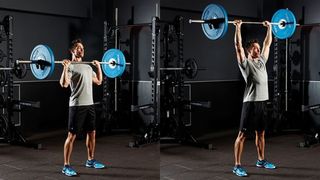
Sets 4 Reps 6-8 Rest 60sec
Why Lifting a heavy weight overhead will work your entire shoulder joint and will also improve your core and abdominal strength because those muscles need to be switched on to stabilise your spine.
How With your feet shoulder-width apart, hold a bar on your upper chest, hands just wider than shoulder-width apart. Brace your abs, glutes and quads as you press the bar straight upwards. Pause at the top, then lower. You may find wrapping your thumbs around the same side as your fingers allows you to lift more weight.
5 Diamond press-up
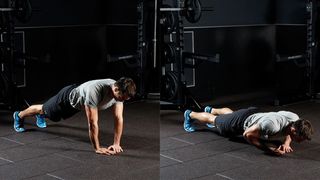
Sets 4 Reps 6 Rest 60-90sec
Why This is a deceptively tough exercise. Moving your hands close together to form a diamond shape will put a lot more emphasis on your triceps. Don’t be surprised if you struggle to hit the rep count if you’re new to this exercise – just focus on maintaining good form.
How Get into a press-up position, placing your hands close together so your thumbs and index fingers touch. Keeping your body in a straight line with your abs braced, lower your torso until your chest is just above the floor, then press back up.
Workout 2: Pull
1 Snatch-grip deadlift
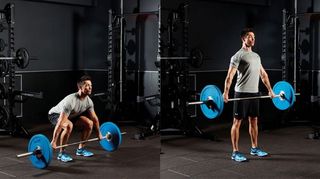
Sets 3 Reps 10 Rest 60sec
Why Any form of deadlift is an excellent full-body exercise that focuses on the posterior chain (the muscles on the back of your body). We’ve gone for the snatch-grip version because the wider grip forces you to reduce the weight and you therefore won’t use up too much energy early in the workout. The next two moves are quite taxing so you want to keep a bit of energy in the tank.
How Hold a barbell with your hands roughly double shoulder-width apart. Push through your heels and keep your chest up as you drive forwards with your hips to lift the bar.
2 Romanian deadlift
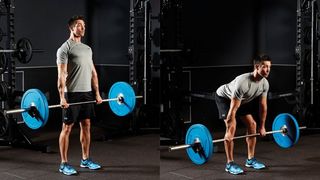
Sets 5 Reps 5 Rest 60-90sec
Why Like the previous move, this develops your glutes and hamstrings, areas that most men would benefit from strengthening. The movement is essentially a hip hinge and has a huge positive carry-over to everyday activity.
How Stand tall with your feet shoulder-width apart, holding a barbell with an overhand grip just outside your thighs. With a slight bend in your knees, bend forwards from the hips and lower the bar down the front of your shins until you feel a good stretch in your hamstrings. Push your hips forwards to reverse the move to the start.
3 Bent-over row
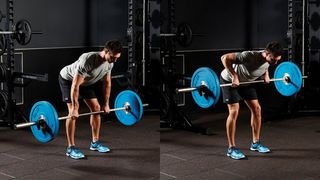
Sets 5 Reps 5 Rest 60-90sec
Why By now your grip should be getting a bit fried but hang on in there for this first-class back-builder. Having a strong back will improve your posture, which will allow you to lift heavy weights safely and also reduce your chances of injury.
How Hold the bar with a shoulder-width grip, bending your knees slightly. Bend at the hips until your torso is at roughly a 45˚ angle to the floor. Pull the bar up to touch your sternum and then lower under control. If you’re moving your upper body to shift the bar, the weight’s too heavy.
4 Biceps curl

Sets 3 Reps 10 Rest 60-90sec
Why You’ve done all of the worthy work. Now it’s time for a bit of guns glory. Don’t be tempted to go too heavy – pick a weight that allows you to complete the reps with a slow eccentric (lowering) phase. And hey presto, you’ll be bursting out of your T-shirt in no time.
How Stand tall with your shoulders back and feet close together, holding a pair of dumbbells with palms facing forwards and hands just outside your hips. Keeping your elbows tucked in to your sides, curl the dumbbells up towards your chest, stopping just before your forearms reach vertical. Lower under control to return to the start position.
Workout 3: Rotation
1 Kettlebell walking lunge
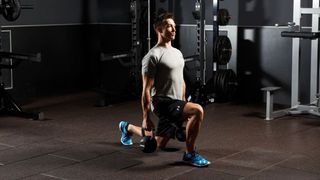
Sets 3 Reps 10 each side Rest 60sec
Why The lunge is an excellent exercise and this version is useful because it increases the co-ordination and stability challenge. You spend a significant amount of time on one leg so your body has to fight the force that are pulling it off balance and out of alignment.
How Start by standing upright with a dumbbell in each hand with plenty of space in front of you. Take a big stride forwards and simultaneously bend both knees until your rear knee is just above the floor. Ensure that your front knee is in line with your front foot and that your knee doesn’t travel in front of your mid-foot. Push through your front foot to stand upright then bring your back leg through to lunge forwards with that leg. Continue that pattern for the duration of the set.
2 Kettlebell windmill
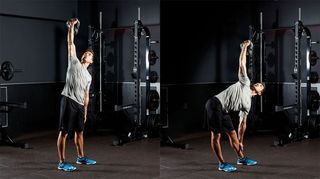
Sets 2 Reps 8 each side Rest 60-90sec
Why This impressive-looking move is one of the most effective abs exercises you can do. It’ll also test your hamstring flexibility and shoulder stability, and it’s vital to concentrate during the entire rep. It’s a tough and technical move but if you persevere and put in the work you’ll be well rewarded.
How Press the kettlebell overhead, then lean your torso forwards and to one side so that your free hand travels down your leg. Keep your arm and back straight throughout. Turn your head at the bottom of the move so you can check that the kettlebell’s directly overhead. Reverse the movement to return to the top position.
3 Russian twist
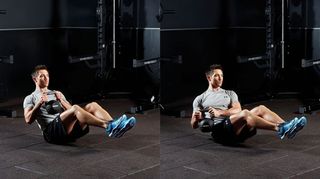
Sets 3 Reps 10 each side Rest 60sec
Why This is a much simpler side abs move than the windmill so we’re introducing it into the workout once you have already been fatigued. The key to getting this part of the weights workout right is slowing it down, really controlling the movement and focusing the tension on your abdominals.
How Sit on the floor with your torso at a 45° angle to the floor and your knees bent. Hold a kettlebell by the handle with both hands then rotate to one side. Return to the middle and rotate to the other side, then return to the middle again to complete one rep. Once you can complete the reps with relative ease, raise your heels a few centimetres off the floor to increase the abs challenge.
4 Kettlebell Turkish get-up
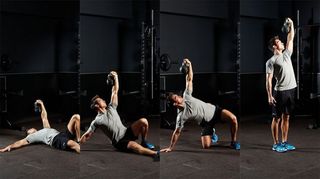
Sets 3 Reps 5 each side Rest 60sec
Why This isn’t something you see the average person doing in a high-street gym, but it has wide-ranging benefits. Each rep involves about 20 seconds of continuous work so it’ll get your heart rate up. It’ll also build full-body strength and enhance your co-ordination and proprioception (your body’s ability to sense and react to its own position).
How Lie on your back with a kettlebell in one hand. Roll slightly away from it as you press it upwards, coming up to support yourself on your opposite forearm. From here, plant the foot on the same side as the kettlebell on the floor, and use it to take your weight as you sweep your other leg underneath you into a half-kneeling position. Stand up with the kettlebell overhead. Reverse the whole movement to go back to the floor.
How To Fuel Your Weights Workouts
Whether you’re using free weights, machines or no weights at all, if you want to get the best results from your training you have to match your efforts in the gym in the kitchen. That’s especially the case if you’re looking to get leaner, because stripping away body fat to better reveal the muscles beneath requires some dietary discipline.
Mostly, you need to do what everyone should already be doing to stay healthy. Get at least five portions of fruit and veg a day – that’s a bare minimum, and the benefits keep increasing the more portions you eat – and aim for 30g of fibre daily too. Opting for wholegrain varieties of carb-rich foods will help you on that front.
Protein is also important, because it’s the fuel your muscles need to repair and rebuild after hard workouts. How much protein should you eat to build muscle? When you’re working out regularly you should aim to eat 1.4-2g of protein per kilo of bodyweight per day, and consuming around 20g of protein shortly after a training session is a good habit to get into.
You can get all the protein you need from your meals, and you should aim to do so since food contains many other vital nutrients alongside protein, but you can also use supplements to make things easier. Our tried-and-tested selections of the best protein powders and best protein bars will help you find a supplement that suits.
If all the above sounds too much like hard work and you just want to focus fully on your training, then you can outsource everything to healthy meal delivery services, some of which will deliver all your meals and snacks daily with a menu built around your training goals. While they’re expensive, using one is undoubtedly a convenient way to support your training.
More weights workouts
- Add Strength And Size With This Full-Body Workout Plan From Shaun Stafford
- Six-Week Strength Training Workout Plan
- A Four-Week Gym Workout Routine To Get Big And Lean

Joe Warner worked for Men’s Fitness UK, which predated, and then shared a website with, Coach. He was a staff writer from 2008 to 2009, then deputy editor until 2013. He returned as editor of Men’s Fitness UK from 2016 to 2019. He is currently group editorial director of IronLife Media and editorial director of the New Body Plan.
Latest about Free-Weight Workouts
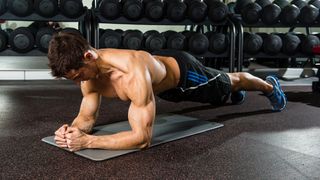
The Best Arm Workout Plan To Build Muscle
By Joe Warner last updated
A four-week arm workout plan to add size and strength to your biceps and triceps while also building a bigger and stronger chest

A Sports Strength & Conditioning Workout To Build Power, Stamina And Strength
By Nick Harris-Fry last updated
This superset gym session will help you excel in your sport

You Need Just Two Dumbbells, Four Moves And 20 Minutes To Build Full-Body Strength
By Alice Porter published
This challenging session is a great option for regular gym-goers
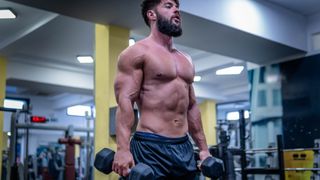
This 10-Minute Dumbbell Workout Uses The Latest Science To Help You Get Stronger, Faster
By Nick Harris-Fry published
Speed through three supersets for an effective 10-minute dumbbell workout that hits the whole body
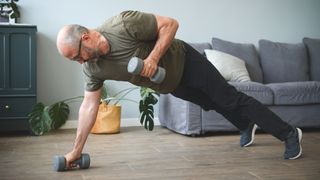
This Fast-Paced Dumbbell Workout For Fat Loss Also Builds Muscle
By Nick Harris-Fry published
Tackle this 30-minute dumbbell workout for fat loss to burn calories, and get stronger and fitter

This Upper-Body Workout Is Ideal For Women Looking To Get Strong
By Alice Porter published
Strengthen your chest, back, shoulders and arms with just a pair of dumbbells
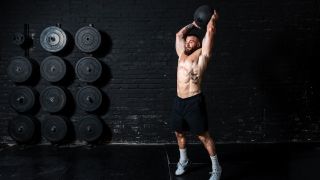
A PT Reveals How To Work Out Like Chris Hemsworth
By Harry Bullmore published
Taking cues from Chris Hemsworth’s recent post, this trainer’s session will help you build muscle and power in 40 minutes
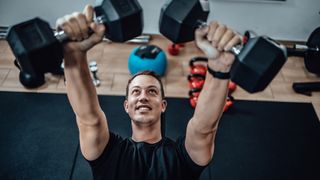
Two Chest And Back Workout Routines For More Muscle
By Nick Harris-Fry, Lucy Gornall last updated
Hit the gym for this six-move chest and back workout, which you can do as a straight sets or supersets
Get the Coach Newsletter
Sign up for workout ideas, training advice, reviews of the latest gear and more.

